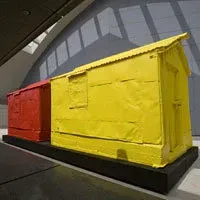Knocking on Dad's Door: Ronnie Van Hout at Te Papa
Written by

By Mark Amery Courtesy of The Dominion Post
Nothing more epitomises the awkwardness of Te Papa's internal architecture and its status as national-gallery-as-afterthought than its Sculpture Terrace.
Where? Many will ask. A roof area requiring two separate lift rides to visit, I still regularly lose my bearings finding it. The work commissioned for this space is generally excellent, but it often looks as in keeping with its surroundings as a prized painting might in your broom cupboard. By Mark Amery Courtesy of The Dominion Post
Nothing more epitomises the awkwardness of Te Papa's internal architecture and its status as national-gallery-as-afterthought than its Sculpture Terrace.
Where? Many will ask. A roof area requiring two separate lift rides to visit, I still regularly lose my bearings finding it. The work commissioned for this space is generally excellent, but it often looks as in keeping with its surroundings as a prized painting might in your broom cupboard.Which is perhaps why Ronnie Van Hout's replicas of a toolshed seem fitting here. The space feels utilitarian, and the two brightly coloured sheds' awkwardness on site are in keeping with the endearing awkwardness Van Hout often brings when he fills a gallery with objects. Van Hout deliberately explores the awkwardness of the replication of things and the air of absence this brings. He immediately makes you feel curious as to what on earth is going on.
These are plastic replicas of his deceased father's toolshed at his childhood home in Aranui, Christchurch - a shed that was kept locked and out of bounds from the young Van Hout. It's a nice companion piece to Van Hout's superb project for TV series New Artland where he got a plaque installed outside the house stating he was born there, complete with opening mayoral reception (the series is recommended viewing at TVNZ on Demand on the web).
In one shed, rather magically, Van Hout replicates the contents of the original - from its beer fridge to its tools and tool bench. Crucially however the shed is locked. You are invited to try and open the door, but then must make do with squinting at its contents through a peephole. The peephole in this way resembles the limited voyeuristic view we have of our past. Interestingly, but rather obscurely, a replica of the padlock for the shed was included in a solo show last year at his dealer's Hamish McKay's in Ghuznee Street.
The second replica, directly behind it, is like the father-son double (and a nod to Van Hout's interest in the body double). The Te Papa media release told me that this second shed "emanates sound and light suggesting an unseen occupant engaged in activity within," yet both times I've visited nothing has "emanated" and I've never encountered a Te Papa Host on the terrace to ask if I'm missing something.
McKay tells me that there's not supposed to be another component, the idea being that things can be reproduced even through memory. This I get, but given the work relies already on a negotiation of frustration of not gaining access, and the animation of objects with sound and moving image is often a key part of Van Hout's practise, it's hard not to feel a little let down rather than engaged with this idea.
Van Hout's work is entitled 'A Loss, Again' and it remains a rather interesting exploration of how the replication of objects can't make up for the loss of the original. Van Hout has finally got his hands on the shed that he was denied access to, and not only entered his father's domain but elevated the ultimate male keepsake to art. In replicating the shed as sculptor he's had to get intimate with its every groove and pockmark, yet reduced the shed to giant brightly-coloured toy blocks to play with.
Van Hout is contemplating the contemporary value of the object and sculpture. While Van Hout replicates reality in detail he also reduces it, Donald Judd-like, to minimalist building blocks. The windows are facsimiles you can't see through, and the bolt on the door has been copied as a cast but doesn't operate. If an artwork is a copy how important is the quality of its replication, particularly when the world is full of cheap knock-off copies of everything?
In that recent show at Hamish McKays Van Hout turned fruit and art magazines into glossy art objects and placed them in what resembled a cramped inner city apartment, constructed within the walls of the gallery. Through a cupboard you were also offered a peephole view of a disturbing scene of a naked Van Hout dummy and sleeping military figure. We were the art buyers trapped in our glorified inner city shed, looking voyeuristically out on the sensationalized artist as art object.
The Te Papa sheds remind me of the reconstructions in other museums of artists' studios, like Brancusi's at the Pompidou in Paris and Francis Bacon's, which was reconstructed, paint-smeared paper, floorboards and all at the Hugh Lane Gallery in Dublin. I've always found this perverse - as if one might understand an artist better from their sawdust.
Van Hout elevates the archetypal Kiwi bloke in his shed to such cultural status - which is completely in keeping with Te Papa's underlining of such archetypes. Jeff Thomson's corrugated iron covered Holden would look good next to this work. The whole set-up reminds me of the Golden Days installation downstairs, with its playful recreation of a New Zealand that no longer exists, and a proprietor who like a ghost is heard but not seen.
A Loss, Again, Ronnie Van Hout and Oddooki, Seung Yul Oh, Te Papa, until May 2009
Image: A loss, again, 2008 by Ronnie van Hout, epoxy resin, polystyrene, polyurethane foam, acrylic paint, found objects and light source.
Image courtesy of Museum of New Zealand Te Papa Tongarewa.
21/01/09